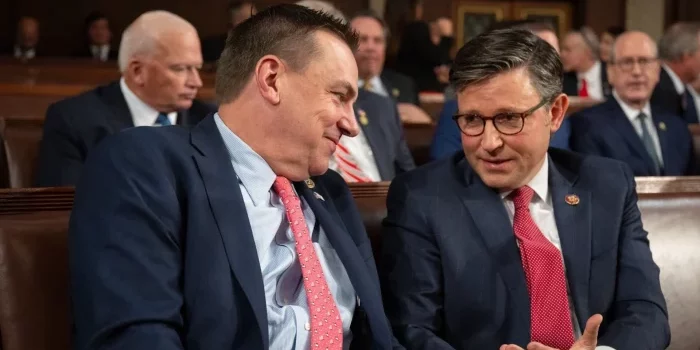(Following more than 10 hours of discussion, the House Budget Committee voted along party lines Thursday night to advance a $4.5 trillion budget resolution that lays out funding plans for President Donald Trump’s border, defense, and energy policies.
It also extends Trump’s 2017 tax cut for the next 10 years, adding at least $2 trillion to the federal deficit even if America experiences strong economic growth.
House Budget Committee Chair Jodey Arrington, R-Texas, told lawmakers the resolution is “a blueprint for restoring America’s security, prosperity, and leadership in the world.”
“This reconciliation process is not just an exercise in matching revenues with outlays,” Arrington said.
“More importantly, it’s reconciling the difference between the American people’s interest, expectations and values, and a federal government that has lost its way, forgotten who it serves, and too often has failed to faithfully, fairly, and efficiently execute the law of the land,” he added.
To partially accommodate its large price tag, the House budget resolution raises the debt ceiling by $4 trillion and instructs congressional committees to find at least $1.5 trillion in spending cuts over the next ten years. That amounts to roughly $150 billion annually in savings.
In return, the resolution authorizes a $300 billion increase in mandatory spending split among the Armed Services, Homeland Security, and Judiciary committees.
Rep. Chip Roy, R-Texas, considered a fiscal hawk, called the plan “a giant step forward” to reduce government spending and inflation.
“I am proud of what the chairman has put forward. I believe that is responsible, and I believe it is a balance of what we’re supposed to do,” said Roy, who was one of the prominent dissenting voices in the last budget standoff, which sought a continuing resolution for the existing spending levels.
“Our government spends too much, and we have to stop that. And the American people deserve to have more money in their pockets,” Roy added. “This budget accomplishes both of those two objectives.”
A Republican amendment to allow adjustments to the spending cuts floor and tax impact cap—a compromise Arrington made with fiscal hardliners like Roy—passed, while none of the Democrats’ amendments made the cut.
But House Democrats vehemently opposed the budget resolution, dubbing it “the Republican rip-off.”
Because the Energy and Commerce Committee is shouldered with roughly $880 billion of the $1.5 trillion in spending cuts, Medicaid and SNAP programs will likely see changes.
“This is a betrayal of the American middle class,” Rep. Brendan Boyle, D-Penn., the Budget Committee’s ranking minority member, told lawmakers.
“This is a betrayal, actually, of the very people who helped make Donald Trump president,” he continued. “Nothing in here whatsoever will bring costs down. In fact, by increasing the deficit, increasing the debt, by including massive tax cuts, all of that will spike inflation.”
The national debt, currently more than $36 trillion, grew by $2.5 trillion in fiscal year 2024 alone and is projected to reach $40.9 trillion by 2027.
Arrington disagreed that the resolution would increase the cost of living, reminding Democrats that “opposing this is going to be a tax hike on families and individuals.”
If the Trump tax cuts expire, the average taxpayer will see a 22% tax hike and their guaranteed deduction slashed in half, according to data from the House Ways and Means Committee.
Despite surviving the committee, the House budget resolution faces another major obstacle before Congress can haggle over specifics: opposition from Republicans in the Senate.
While Arrington and Speaker Mike Johnson, R-La., hashed out the details of the package earlier this week, Senate Republicans got tired of waiting.
Rejecting the House’s one-bill approach, Senate Budget Committee Chair Lindsey Graham, R-S.C., introduced a fully offset $342 billion budget resolution that funds the border and military but puts off the tax cuts extension for a second, later bill.
The Senate budget resolution passed the committee on party lines and advanced Wednesday.
The two different budget resolutions may lead to a showdown between House and Senate Republicans.
The chambers must advance identical budget resolutions before they can move forward in the reconciliation process and craft legislation that implements the budget items.
Congress also doesn’t have much time to spare as government funding runs out on March 14. Lawmakers are still undecided on a top-line number for the appropriations bill.

